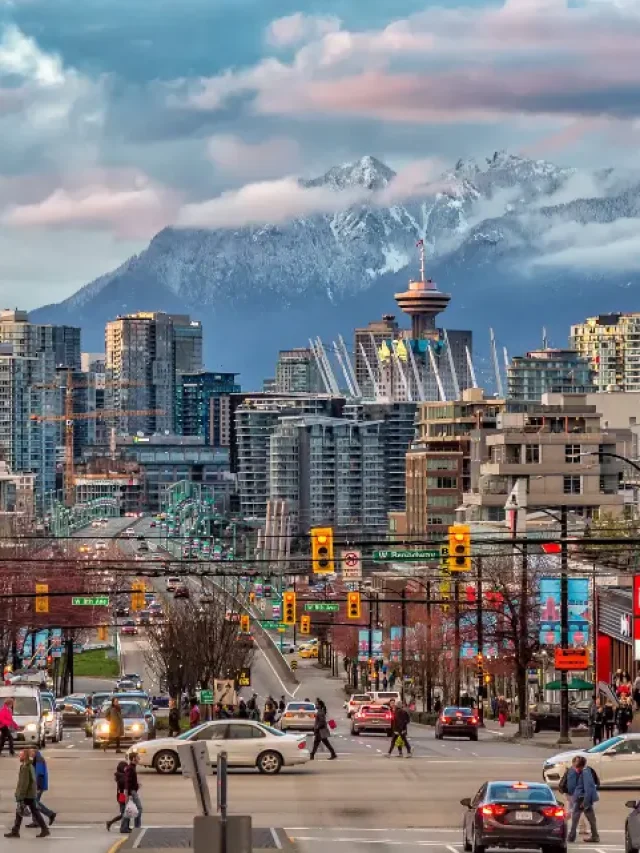Curious about the cost of living in the USA? Or considering moving to the United States for further education? Well, you are at the right place. In this blog, we will take you through a realistic breakdown of the cost of living in the USA in 2025. The cost of living in the USA can vary widely depending on where you are.
But there are some key areas where you’ll notice the most significant expenses. Let’s break it down into five main categories: accommodation, education, food and dining, travel, and utilities. Without further ado, let’s calculate the cost of living in the USA in 2025.
Table of contents
Cost of Accommodation in the USA

When it comes to finding a place to live in the USA, your budget will largely depend on the city or state you choose. Cities like New York, San Francisco, and Los Angeles come with sky-high rents. Factor in additional costs like property taxes, insurance, and maintenance, which can add up quickly.
| Type of Accommodation | Cost of Accommodation |
| Apartment (1 bedroom) in City Centre | USD 1,752.87 |
| Apartment (1 bedroom) Outside of Centre | USD 1,441.94 |
| Apartment (3 bedrooms) in City Centre | USD 2,934.32 |
| Apartment (3 bedrooms) Outside of Centre | USD 2,391.85 |
| The price per Square Meter to Buy an Apartment in the City Centre | USD 3,432.35 |
| Price per Square Meter to Buy an Apartment Outside of Centre | USD 2,761.02 |
Cost of Studying

Education in the USA is a major investment, whether you’re pursuing a degree or just taking a few courses. For public universities, out-of-state students can expect to pay more tuition fees. In-state students often get a discount, bringing their cost of studying down. Additionally, don’t forget about other expenses like textbooks, supplies, and living costs, which can push the total cost of living in the USA even higher.
Here is a breakdown of the top 5 universities and the cost of studying in the USA.
| University | Annual Cost of studying in the USA |
| Harvard University | USD 54,002 |
| Stanford University | USD 56,169 |
| Massachusetts Institute of Technology (MIT) | USD 53,790 |
| California Institute of Technology (Caltech) | USD 54,600 |
| University of Chicago | USD 57,642 |
Also Read: If you love to travel then you must explore these best places for solo travel in San Francisco.
Cost of Food and Restaurants

Eating out and grocery shopping are two significant parts of your food budget. If you’re cooking at home, you may end up paying less in comparison to the cost of dining out. Fresh produce and organic items tend to be pricier, especially in areas where they are less readily available. Major cities often have more expensive dining options, but there are also plenty of affordable choices if you know where to look. There are various cafes and restaurants in the USA offering affordable choices.
| Food and Restaurant in the USA | Cost of Food and Restaurant |
| Meal, Inexpensive Restaurant | USD 20.00 |
| Meal for 2 People, Mid-range Restaurant, Three-course | USD 75.00 |
| McMeal at McDonalds (or Equivalent Combo Meal) | USD 11.00 |
| Domestic Beer (0.5 liter draught) | USD 6.00 |
| Imported Beer (0.33 liter bottle) | USD 7.00 |
| Cappuccino (regular) | USD 5.15 |
| Coke/Pepsi (0.33 liter bottle) | USD 2.52 |
| Water (0.33 liter bottle) | USD 2.05 |
Cost of Travel and Transportation

Getting around in the USA can be a significant expense. If you’re using public transportation, monthly passes are one of the best ways for affordable transportation. In big cities like New York or San Francisco, the subway and bus systems are comprehensive and convenient, while smaller cities might have less frequent service. If you prefer driving, you’ll need to consider the cost of owning a car, which includes car payments, insurance, gas, and maintenance.
| Travel and Transportation in the USA | Cost |
| One-way Ticket (Local Transport) | USD 2.50 |
| Monthly Pass (Regular Price) | USD 67.00 |
| Taxi Start (Normal Tariff) | USD 3.52 |
| Taxi 1km (Normal Tariff) | USD 1.71 |
| Taxi 1hour Waiting (Normal Tariff) | USD 30.00 |
| Gasoline (1 liter) | USD 0.96 |
| Volkswagen Golf 1.4 90 KW Trendline (Or Equivalent New Car) | USD 33,680.68 |
| Toyota Corolla Sedan 1.6l 97kW Comfort (Or Equivalent New Car) | USD 26,155.26 |
Cost of Utilities and Internet

Utilities and the Internet are something that you must consider while calculating the cost of living in the USA. Utilities include electricity, heating, cooling, water, and garbage collection. This amount can vary based on the size of your home, the climate where you live, and your personal usage. Keep in mind that in some remote areas, internet options might be limited or more expensive.
| Utilities | Cost |
| Basic (Electricity, Heating, Cooling, Water, Garbage) for 85m2 Apartment | USD 207.36 |
| Mobile Phone Monthly Plan with Calls and 10GB+ Data | USD 54.63 |
| Internet (60 Mbps or More, Unlimited Data, Cable/ADSL) | USD 70.97 |
Also Read: If you want to experience the nightlife of Belfast, then you must try out these bars in Belfast with your friends.
Strategies to Manage Costs
Managing costs effectively is essential for maintaining financial stability and achieving your long-term goals. Whether you’re navigating high housing prices, rising grocery bills, or transportation expenses, adopting smart strategies can make a significant difference. From budgeting wisely to cutting unnecessary costs, small changes can lead to big savings and a more sustainable lifestyle.
- Housing Optimisation
- Consider Relocation: Choose areas with a lower cost of living, such as suburban or rural areas, while maintaining proximity to job opportunities.
- Shared Living: Opt for shared housing or renting out unused rooms to reduce rental or mortgage costs.
- Downsizing: Move to smaller homes or apartments to save on rent, utilities, and maintenance.
- Smart Grocery Shopping
- Meal Planning: Create a weekly meal plan to avoid impulse purchases and reduce food waste.
- Buy in Bulk: Purchase non-perishable items in bulk from warehouse stores like Costco or Sam’s Club.
- Use Discounts and Coupons: Leverage coupons, store loyalty programs, and apps like Ibotta to save money.
- Transportation Savings
- Public Transit: Use public transportation instead of owning a car, especially in urban areas where transit systems are efficient.
- Carpooling and Ridesharing: Share rides with coworkers or use apps like Uber Pool to cut down on commuting costs.
- Maintain Your Vehicle: Regular maintenance improves fuel efficiency and prevents costly repairs.
- Reduce Utility and Entertainment Expenses
- Energy Efficiency: Switch to energy-efficient appliances and reduce energy use by using programmable thermostats and LED lighting.
- Bundle Services: Combine phone, internet, and TV services to reduce monthly bills.
- Cut Unnecessary Subscriptions: Review subscriptions and cancel those that are underused, such as streaming services or gym memberships.
- Financial Planning and Budgeting
- Track Expenses: Use apps like Mint or YNAB to monitor spending and identify areas for cost-cutting.
- Build an Emergency Fund: Set aside savings to avoid relying on credit in unexpected situations.
- Seek Discounts: Look for deals on everything from clothing to entertainment, and take advantage of free community events for recreation.
FAQs About Cost of Living in the USA
The estimated cost of living in the USA is around USD 10,000 to USD 18,000 per year.
The average cost of living in the USA for Indian students ranges between USD 1,100 to USD 1,200 per month.
Students often face higher costs for accommodation, tuition, and textbooks. Many students manage by taking on part-time jobs, applying for scholarships and financial aid, and budgeting carefully.
Yes, there are often hidden costs such as health insurance, which can be significant if not covered by an employer or school. Additionally, taxes, including state and local taxes, can impact your overall budget.
While large cities often have higher living costs, it is possible to find more affordable housing options if you look beyond the city centre. Exploring up-and-coming neighbourhoods or nearby suburbs can offer more budget-friendly alternatives.
Healthcare in the USA is among the most expensive in the world, with high insurance premiums, copays, and out-of-pocket expenses, even with employer-sponsored plans.
Yes, rural areas generally have lower housing, grocery, and transportation costs but may lack amenities like public transportation and high-paying job opportunities.
Transportation costs depend on factors like fuel prices, vehicle ownership, and public transit availability. Cities with efficient public transportation, like New York, may reduce commuting costs significantly.
Utility costs, including electricity, water, and internet, can range from USD 150–USD 400 per month, varying with climate, household size, and energy efficiency.
States like California, New York, and Hawaii have the highest costs, while states like Mississippi, Arkansas, and West Virginia are among the most affordable.
Hope you liked reading about the cost of living in the USA. Embark on your study abroad journey with comfort and convenience. Reach out to Fly Homes now at 1800572118 to secure the finest student accommodation abroad.
Follow Us on Social Media




























